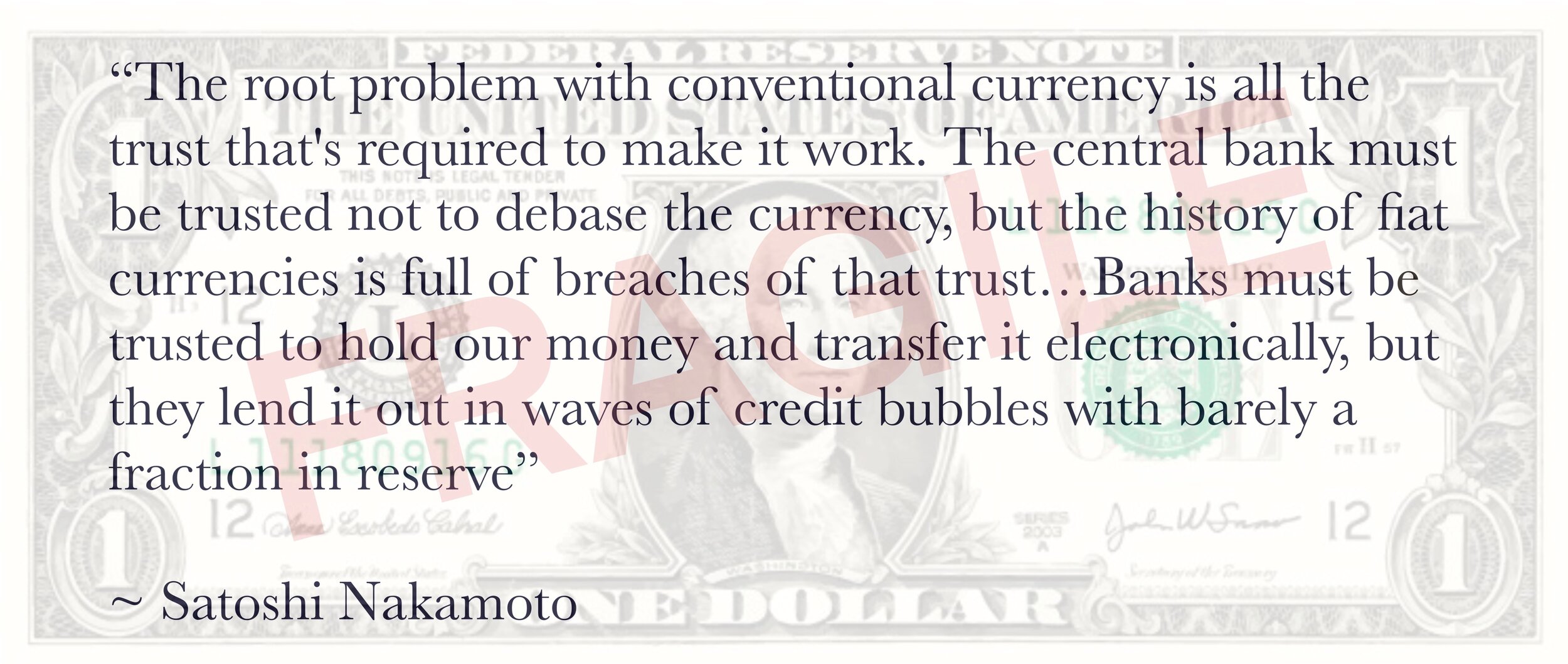
Teach. Learn. Bitcoin
Bitcoin could be the answer…
A decentralized peer-to-peer network that creates consensus without the necessity for any trusted 3rd parties (no more banks!). The token issued on the network is bitcoin, and it is provided as reward to miners (watch this excellent lecture on mining). Bitcoin is the hardest money to ever exist, and has never been hacked or shut down since its inception in 2009 (but this hasn’t stopped people writing its obituary). To fully understand why Bitcoin is important, you must first understand money: its history and how it works. For further reading, please visit our recommended reading list, and blog.

Why Bitcoin?
Bitcoin is the hardest money to ever exist, and is the pinnacle of monetary technology (read this excellent article)
As more and more fiat currency is created out of thin air, artificially inflating asset prices, there is perhaps no better time to invest in hard money assets like bitcoin and gold (Read this short article on why bitcoin may be the superior choice)
Bitcoin is the best performing asset in the last decade, growing an incredible 150-200% annually, but not without its fair share of volatility along the way (read more on volatility here)
Just a 2.5% allocation to bitcoin in a traditional 60/40 stock-bond portfolio, increased cumulative returns from 26% to nearly 45% over a 6 year period with very little change to overall volatility. A 5% allocation boosted those returns to 65% over the same period (according to a Bitwise study). In other words, a small allocation brings with it the potential for remarkable upside, even for those with a low risk appetite
Bitcoin has a 100% transparent inflation schedule written indelibly into its code. We know there will only ever be 21 million bitcoins in existence, and that if demand continues to increase, so too will the price. Bitcoin is a superlative store of value (read this excellent article on the subject)
There is no simpler investment decision. If you believe demand will remain the same or increase, then the price will continue to trend upward as daily supply inflation is halved approximately every 4 years (more on bitcoin’s supply and demand). Other assets, such as stocks or precious metals are not so simple. For example, if the demand for gold rises, the financial incentive for miners follows. This subsequently floods the market with more supply to meet the demand. This is not to mention the pervasive market manipulation and the potential for new mining technology/methods (such as space/deep-sea mining which could lead to even more dramatic supply inflation and price suppression as a result.) The same problem exists with stocks, but potentially to an even greater degree. As the demand and price of a stock rises, so too does the incentive for the company to issue even more shares and subsequently dilute your holding. We know with absolute certainty that 6.25 bitcoins will be minted approximately every 10 minutes until 2024, when that number will halve. This process will continue every 4 years until all 21 million are mined. Scarcity only increases
Price predictions are not usually accurate or helpful, but the stock-to-flow ratio provides some interesting context. There are currently 18.7 million bitcoins in circulation, with a current supply inflation (flow) of 328,500 per year. This gives us a stock-to-flow ratio of 56.9, meaning it would take 56.9 years to get the current stock of bitcoin. The stock-to-flow ratio of gold, the scarcest physical asset on Earth, is an estimated 55.9. Bitcoin is scarcer. If we look at the price movement of bitcoin in relation to this ratio, we see that it has invariably stepped higher into each halving of the flow (view the chart here)
You are still early. The market cap of bitcoin is currently around $700 billion. To bring that into perspective, gold and silver have respective market caps of around $12 trillion and $1.5 trillion. Gold and silver have been used as store-of-value assets for thousands of years, but Bitcoin stands as a viable and in many ways superior alternative to the metals. If bitcoin reaches the market cap of gold, its price will be over 500,000 USD. Just something to think about
According to one study, just 1.3% of the world’s population is currently holding bitcoin. Again, you are still early. *It is important to note here, as this is based on wallet data, that addresses are not people. Just as multiple people can have access to the same lockbox, any number of people can have access to a single Bitcoin wallet address
Ignore the noise and short-term price movement, and focus on the facts. On-chain metrics (available to study here) show us that hash-rate is trending upward, and thus the network is growing more and more secure (what is hash-rate and why is it so important?). “Bitcoin is a swarm of cyber hornets serving the goddess of wisdom, feeding on the fire of truth, exponentially growing ever smarter, faster, and stronger behind a wall of encrypted energy” (Michael Saylor, CEO of MicroStrategy)
Our legacy financial system is fervently fighting against the ever-growing deflationary forces of technology, with its inflationary monetary policy. But why? Is inflation really necessary? Who does it benefit? Do central banks really have our best interests in mind?
At Teach Learn Bitcoin, we believe Bitcoin could be the answer to all these questions. Spread the word!
Try, with all your might, to ignore the noise



